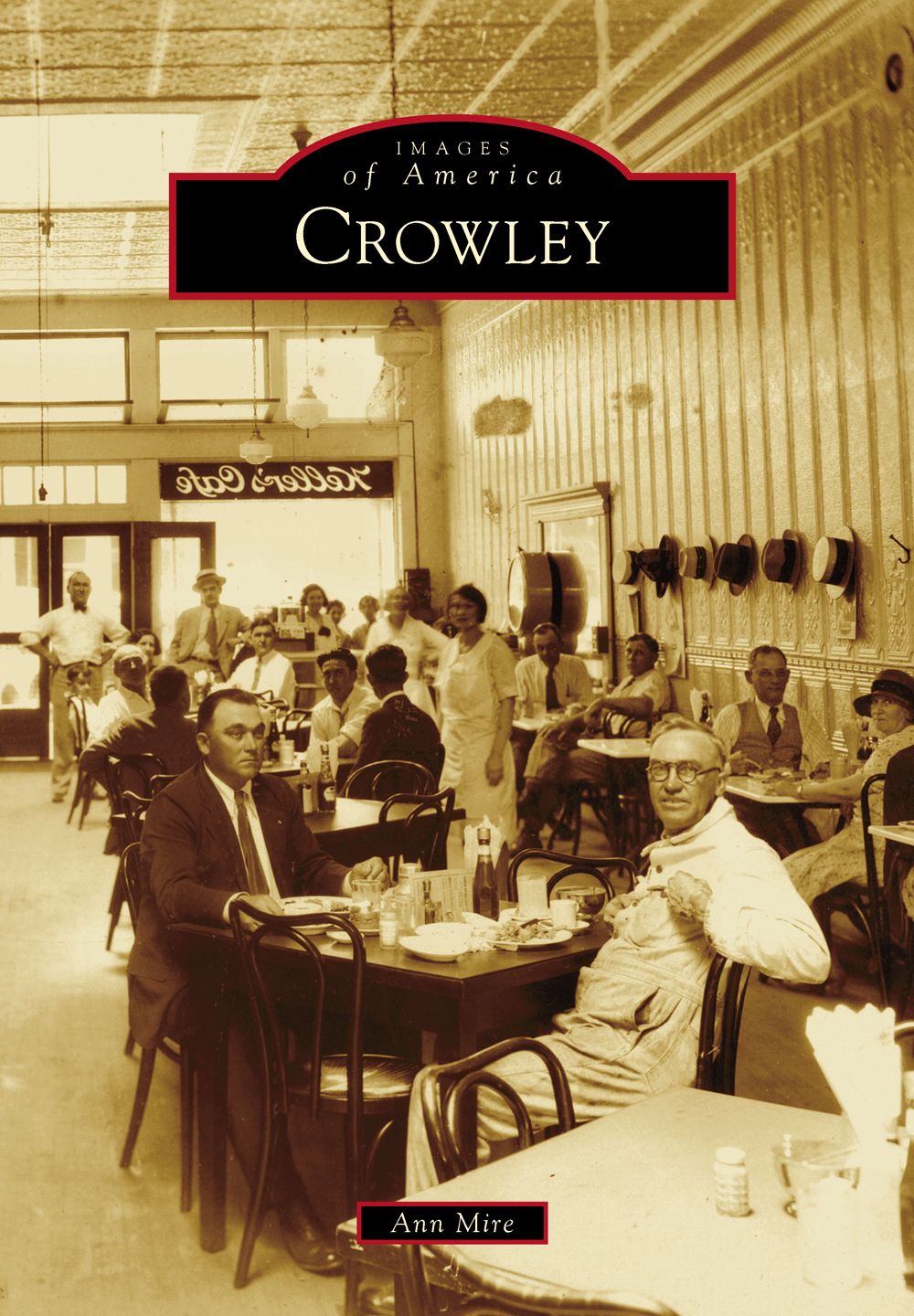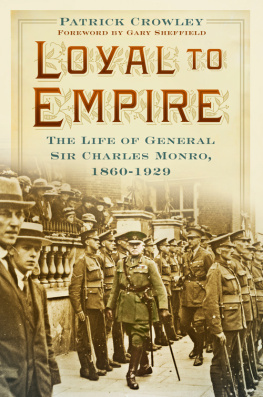
IMAGES
of America
CROWLEY

This map shows the one-square-mile grid of Crowley, bounded by Eastern, Northern, and Western Avenues and the Southern Pacific Railroad. Radiating from the center square, the location of the courthouse, are Parkerson and Hutchinson Avenues. Parkerson Avenue, named for the general manager of the Louisiana Western Railroad, runs north and south, while Hutchinson Avenue, named for the general manager of the Southern Pacific Railroad, runs east and west. (Courtesy of Dorothy McNeely.)
ON THE COVER: Kellers Caf began as a coffee and sandwich stand about 1925. A new brick building was constructed in 1927 at 122 North Parkerson Avenue. Relocated to 206 West Second Street in 1949, the restaurant closed around 1958. Proprietor Rudolph Keller (18871965), pictured in the doorway, was known as Crowleys Santa Claus because for many years he played that role at civic and church functions. (Courtesy of Freeland Archives.)
IMAGES
of America
CROWLEY
Ann Mire

Copyright 2014 by Ann Mire
ISBN 978-1-4671-1229-1
Ebook ISBN 9781439647202
Published by Arcadia Publishing
Charleston, South Carolina
Library of Congress Control Number: 2014945502
For all general information, please contact Arcadia Publishing:
Telephone 843-853-2070
Fax 843-853-0044
E-mail
For customer service and orders:
Toll-Free 1-888-313-2665
Visit us on the Internet at www.arcadiapublishing.com
This book is lovingly dedicated to my family and friends and to the people of Crowley, who have welcomed me into their town, homes, and hearts.
CONTENTS
ACKNOWLEDGMENTS
Much of Crowleys history was preserved by Rev. Paul B. Freeland. Among these archival materials are many photographs. The Freeland Archives are housed in the Acadia Parish Library in Crowley, Louisiana. Among those who contributed to the further organization of the archives are Dorothy B. McNeely and members of the Point de lEglise: Acadia Genealogical and Historical Society.
Crowleys history has been recorded in Dorothy McNeelys Crowley: The First Hundred Years, 18871987 as well as Acadia Parish, Louisiana: A History to 1900 by Mary Alice Fontenot and Rev. Paul B. Freeland, and Acadia Parish, Louisiana: A History to 1920, Volume II by Mary Alice Fontenot. Many early Crowley photographs were published in A Pictorial History of Crowley, Louisiana, by the Crowley Post-Signal. L.A. Williamss Sidewalk Talks contains valuable information on the history of Crowleys businesses, residences, and pioneers.
Most of the photographs within the collection were taken by B.A. Barnett. Other photographs were taken by early Crowley photographers George Bellar and E.K. Studervant, as well as the staff of Crowley newspapers, including the Daily Signal, Crowley Signal, Crowley Post Herald, and the Crowley Post-Signal. Unless otherwise noted, all images appear courtesy of Freeland Archives, Acadia Parish Library.
For assistance in choosing photographs, I express my heartfelt appreciation to Florette Bergeron, Lee Lawrence, and Amy Thibodeaux. An extra thanks to Amy for formatting the photographs. For his invaluable assistance in preparing the chapter on the rice industry, I thank Dr. Tim Croughan. A big thank-you is extended to Karen Welch for her invaluable assistance in researching information on Crowley businesses and residences. Thanks to Amanda Meyer for help with research. I am most grateful to Dr. Richard Bier, who took the time to read the manuscript.
I acknowledge and thank all those who have provided photographs from their private collections. I am grateful to all who helped in the identification of people in the photographs.
Last, but certainly not least, I am grateful to Ted Landry, Acadia Parish Library director, for his support and encouragement in this project. I am also thankful to each member of the Crowley Library staff for their support.
INTRODUCTION
Picture the high grasses of prairie land as the first trains crossed southwest Louisiana in 1881. While most passengers saw a barren wasteland, one man dreamt of building a city there. With several businessmen from Opelousas, W.W. Duson organized the Southwestern Louisiana Land Company in July 1886. Along with his brother C.C. Curley Duson, the stockholders included Alphonse Levy, Julius Meyer, Joseph Bloch, G.W. Hudspeth, and Henry Garland. Their first action was to purchase 174 acres of what would become the center of Crowley at the price of 45 an acre.
The designer of the grid plan for the town was St. Landry Parish surveyor Leon Fremaux. Over 100 young men cleared the high grasses and brush as the land was surveyed and the streets were marked off. Pulled by eight oxen, a grader driven by Thomas J. Toler and Curley Duson marked the blocks with 16 lots each. A square in the center would be the site for a courthouse, as Crowley was chosen as the seat for the newly formed Acadia Parish in 1886. South Crowley would be laid out in 1897, followed by an auction of many lots.
With his town cleared off and laid out, Duson had his real estate office moved by oxcart from Rayne to Crowley. The question of naming the town then had to be resolved. Crowleys Switch, a house depot managed by road master Patrick Crowley, was located seven miles west of the townsite. Persuaded by Duson, the railroad company moved the depot on flatcars to the new townsite. In exchange, the newly formed town was named Crowley.
Not only were supplies brought to the townsite by rail, but also the first store, which was run by Jac Frankel. He operated it out of a freight car until his store building was constructed. The stores opening day, January 4, 1887, is considered the birthday of Crowley. By the end of that month, Crowley could also boast a schoolhouse, a storehouse, a livery stable, the Southern Pacific depot, and the Crowley House.
Purchasing the Rayne Signal newspaper, Duson renamed it the Crowley Signal and moved it to Crowley. Then he began a concerted effort to encourage families from the North and Midwest to immigrate to Crowley. Using special advertising in the newspapers of those regions, he touted not only the climate and agricultural opportunities, but also the schools and churches that were being built in Crowley. Furthermore, railroad excursions from those states to Louisiana often included a stop in Crowley.
The Southwestern Louisiana Land Company was responsible for building the first storehouse, hotel (Crowley House), livery stable, and schoolhouse. Interestingly, during the greatest period of business construction, from 1899 to 1903, many of the old structures were moved into the middle of Parkerson Avenue so that business could continue to be conducted as new buildings were erected. When fruit dealer Chris Memtsass building was removed from the street in February 1903, an unobstructed view from the depot to the courthouse was the result.
Early pioneers grew what was known as providence rice. Planted in shallow ponds, the crop depended upon the divine providence of rainfall for its success. However, as a canal and irrigation system began to be developed through the efforts of the Abbott brothers and the Freeland brothers, there was more certainty in raising a good crop. With the arrival of Salmon Sol Wright in 1890 and his development of a better rice grain, as well as the proliferation of rice mills, the area became known for its rice industry.
Next page








